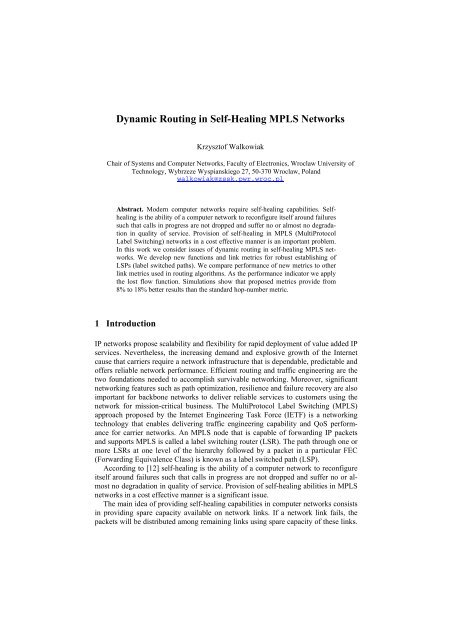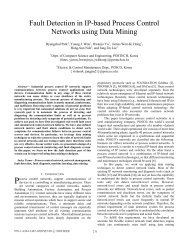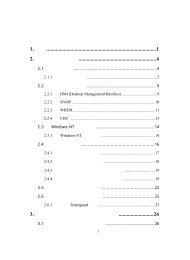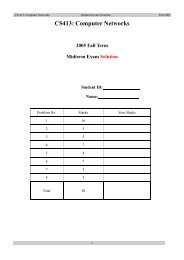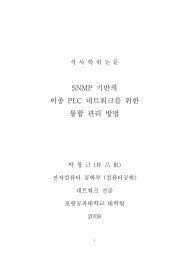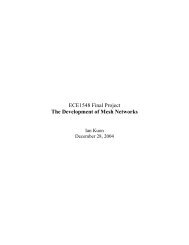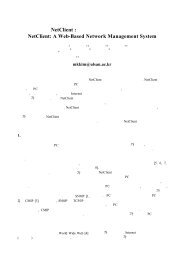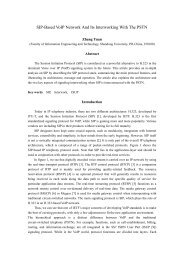Dynamic Routing in Self-Healing MPLS Networks - (Distributed ...
Dynamic Routing in Self-Healing MPLS Networks - (Distributed ...
Dynamic Routing in Self-Healing MPLS Networks - (Distributed ...
You also want an ePaper? Increase the reach of your titles
YUMPU automatically turns print PDFs into web optimized ePapers that Google loves.
<strong>Dynamic</strong> <strong>Rout<strong>in</strong>g</strong> <strong>in</strong> <strong>Self</strong>-Heal<strong>in</strong>g <strong>MPLS</strong> <strong>Networks</strong>Krzysztof WalkowiakChair of Systems and Computer <strong>Networks</strong>, Faculty of Electronics, Wroclaw University ofTechnology, Wybrzeze Wyspianskiego 27, 50-370 Wroclaw, Polandwalkowiak@zssk.pwr.wroc.plAbstract. Modern computer networks require self-heal<strong>in</strong>g capabilities. <strong>Self</strong>heal<strong>in</strong>gis the ability of a computer network to reconfigure itself around failuressuch that calls <strong>in</strong> progress are not dropped and suffer no or almost no degradation<strong>in</strong> quality of service. Provision of self-heal<strong>in</strong>g <strong>in</strong> <strong>MPLS</strong> (MultiProtocolLabel Switch<strong>in</strong>g) networks <strong>in</strong> a cost effective manner is an important problem.In this work we consider issues of dynamic rout<strong>in</strong>g <strong>in</strong> self-heal<strong>in</strong>g <strong>MPLS</strong> networks.We develop new functions and l<strong>in</strong>k metrics for robust establish<strong>in</strong>g ofLSPs (label switched paths). We compare performance of new metrics to otherl<strong>in</strong>k metrics used <strong>in</strong> rout<strong>in</strong>g algorithms. As the performance <strong>in</strong>dicator we applythe lost flow function. Simulations show that proposed metrics provide from8% to 18% better results than the standard hop-number metric.1 IntroductionIP networks propose scalability and flexibility for rapid deployment of value added IPservices. Nevertheless, the <strong>in</strong>creas<strong>in</strong>g demand and explosive growth of the Internetcause that carriers require a network <strong>in</strong>frastructure that is dependable, predictable andoffers reliable network performance. Efficient rout<strong>in</strong>g and traffic eng<strong>in</strong>eer<strong>in</strong>g are thetwo foundations needed to accomplish survivable network<strong>in</strong>g. Moreover, significantnetwork<strong>in</strong>g features such as path optimization, resilience and failure recovery are alsoimportant for backbone networks to deliver reliable services to customers us<strong>in</strong>g thenetwork for mission-critical bus<strong>in</strong>ess. The MultiProtocol Label Switch<strong>in</strong>g (<strong>MPLS</strong>)approach proposed by the Internet Eng<strong>in</strong>eer<strong>in</strong>g Task Force (IETF) is a network<strong>in</strong>gtechnology that enables deliver<strong>in</strong>g traffic eng<strong>in</strong>eer<strong>in</strong>g capability and QoS performancefor carrier networks. An <strong>MPLS</strong> node that is capable of forward<strong>in</strong>g IP packetsand supports <strong>MPLS</strong> is called a label switch<strong>in</strong>g router (LSR). The path through one ormore LSRs at one level of the hierarchy followed by a packet <strong>in</strong> a particular FEC(Forward<strong>in</strong>g Equivalence Class) is known as a label switched path (LSP).Accord<strong>in</strong>g to [12] self-heal<strong>in</strong>g is the ability of a computer network to reconfigureitself around failures such that calls <strong>in</strong> progress are not dropped and suffer no or almostno degradation <strong>in</strong> quality of service. Provision of self-heal<strong>in</strong>g abilities <strong>in</strong> <strong>MPLS</strong>networks <strong>in</strong> a cost effective manner is a significant issue.The ma<strong>in</strong> idea of provid<strong>in</strong>g self-heal<strong>in</strong>g capabilities <strong>in</strong> computer networks consists<strong>in</strong> provid<strong>in</strong>g spare capacity available on network l<strong>in</strong>ks. If a network l<strong>in</strong>k fails, thepackets will be distributed among rema<strong>in</strong><strong>in</strong>g l<strong>in</strong>ks us<strong>in</strong>g spare capacity of these l<strong>in</strong>ks.
Most of self-heal<strong>in</strong>g methods use shar<strong>in</strong>g of spare capacity for various failure events.This approach yields a cost effective self-heal<strong>in</strong>g restoration.Provid<strong>in</strong>g self-heal<strong>in</strong>g <strong>in</strong>cludes many aspects: spare capacity allocation, rerout<strong>in</strong>gstrategies, how traffic is distributed, failure detection, propagation of <strong>in</strong>formationabout failure, network control [1], [8]. In this work we focus on problems of sparecapacity allocation <strong>in</strong> exist<strong>in</strong>g <strong>MPLS</strong> networks. We consider an exist<strong>in</strong>g <strong>MPLS</strong> network,i.e. the network topology and l<strong>in</strong>k capacity are given. Our ma<strong>in</strong> goal is to provideroutes for all demands <strong>in</strong> order to use the network capacity efficiently <strong>in</strong> terms ofnetwork reliability. It must be noted that hav<strong>in</strong>g the network resource and a trafficdemand, the routes assignment determ<strong>in</strong>es spare capacity allocation over the network.Thus, assignment of routes has an effect on the amount of flow restored when a failureoccurs [9]. Therefore, the ma<strong>in</strong> objective of this paper is to develop new metrics(weights) for routes calculation. Us<strong>in</strong>g these metrics should provide effective allocationof spare capacity that enables restoration of flow after a network failure. To makean evaluation of proposed metrics we compare performance of these metrics withperformance of other metrics used <strong>in</strong> non-reliable dynamic rout<strong>in</strong>g, e.g. the hopnumbermetric. Results of extensive simulation tests are presented and discussed.2 <strong>Self</strong>-heal<strong>in</strong>g <strong>MPLS</strong> <strong>Networks</strong><strong>Self</strong>-heal<strong>in</strong>g <strong>MPLS</strong> networks realize fast restoration from a network failure byswitch<strong>in</strong>g affected LSPs over alternate routes. There are two models for path recovery<strong>in</strong> <strong>MPLS</strong>: rerout<strong>in</strong>g and protection switch<strong>in</strong>g. Recovery by rerout<strong>in</strong>g is def<strong>in</strong>ed asestablish<strong>in</strong>g new paths on demand for restor<strong>in</strong>g traffic after the occurrence of a failure.The recovery paths may be found us<strong>in</strong>g network rout<strong>in</strong>g policies, precomputedconfigurations and network topology <strong>in</strong>formation. After detect<strong>in</strong>g a failure, paths areestablished us<strong>in</strong>g signal<strong>in</strong>g. S<strong>in</strong>ce more operations must be done, rerout<strong>in</strong>g is muchslower than protection switch<strong>in</strong>g mechanism. However, while network resources havenot to be reserved until the failure, rerout<strong>in</strong>g is easier. Protection switch<strong>in</strong>g recoverymechanisms use preestablished recovery paths, based upon network rout<strong>in</strong>g policies,the restoration requirements of the traffic on the work<strong>in</strong>g path, and adm<strong>in</strong>istrativeconsiderations. When a failure occurs, the protected traffic is switched over to therecovery path(s) and restored. It must be noted that protection switch<strong>in</strong>g and rerout<strong>in</strong>gmay be used together. For <strong>in</strong>stance, <strong>in</strong> order to recover onl<strong>in</strong>e a failed path andprovide connectivity protection switch<strong>in</strong>g may be used. Rerout<strong>in</strong>g may be applied todeterm<strong>in</strong>e a new optimal network configuration and rearrange paths <strong>in</strong> offl<strong>in</strong>e manner[11].There are three configurations of work<strong>in</strong>g and recovery paths for rerout<strong>in</strong>g andprotection switch<strong>in</strong>g <strong>in</strong> <strong>MPLS</strong> networks [2], [3], [11]: Local repair. Known also as local recovery, protects the work<strong>in</strong>g path aga<strong>in</strong>st al<strong>in</strong>k or neighbor node failure. Local repair can be of two types: l<strong>in</strong>k recovery/restoration,node recovery/restoration. The former one assumes, that the recoverypath routes around a failed l<strong>in</strong>k. The alternate path is found between the twoLSRs on the ends of a failed l<strong>in</strong>k. In latter case, the recovery path may be configuredto route around a failed neighbor node. The ma<strong>in</strong> advantage of local repair is
fast propagation of a failure <strong>in</strong>formation and simplicity. The node upstream of thefailure is responsible for <strong>in</strong>itiation of the recovery process and switch<strong>in</strong>g the trafficto a recovery path. Global repair. The ma<strong>in</strong> idea of global repair, called also edge-to-edge rerout<strong>in</strong>g, isto protect the work<strong>in</strong>g path aga<strong>in</strong>st any l<strong>in</strong>k or node fault on a path, except thefailures occurr<strong>in</strong>g at the <strong>in</strong>gress node of the protected path. It means that the recoverypath must be l<strong>in</strong>k and node disjo<strong>in</strong>t from the work<strong>in</strong>g path. It has the advantageof protect<strong>in</strong>g aga<strong>in</strong>st all l<strong>in</strong>k and node failures on the work<strong>in</strong>g path. Thema<strong>in</strong> drawback is slower reaction to a failure than for local repair. Reverse backup. In the reverse backup approach the traffic of failed l<strong>in</strong>k is reversedfrom the po<strong>in</strong>t of a failure, i.e. the <strong>in</strong>gress node of the failed l<strong>in</strong>k, back tothe source (<strong>in</strong>gress) node of the protected work<strong>in</strong>g path. That node reroutes <strong>in</strong>com<strong>in</strong>gtraffic to alternative recovery paths. Major benefit is relatively small time ofrestoration, s<strong>in</strong>ce the failure notification is simplified. The ma<strong>in</strong> disadvantage isreduced resource utilization. Two recovery paths are needed: one from the po<strong>in</strong>t offailure to the <strong>in</strong>gress node of the path and the second one from the <strong>in</strong>gress node tothe egress node of the protected path.LSR4LSR4LSR4LSR7LSPwork<strong>in</strong>gpathLSR7LSPwork<strong>in</strong>gpathLSR7LSPwork<strong>in</strong>gpathLSPrecoverypathLSR3LSPrecoverypathLSR3LSPrecoverypathLSR3LSR6LSR6LSR6LSR2LSR2LSR2LSR5LSR5LSR5LSR1LSR1reversebackupLSPLSR1(a) (b) (c)Fig. 1. <strong>MPLS</strong> rerout<strong>in</strong>g strategies: (a) Global repair, (b) Local repair, (c) Reverse backupFig. 1 illustrates three configurations of work<strong>in</strong>g and recovery paths for rerout<strong>in</strong>gand protection switch<strong>in</strong>g. The work<strong>in</strong>g LSP 1-2-3-4 connect<strong>in</strong>g LSR1 and LSR 4 isbroken when the l<strong>in</strong>k 2-3 fails. For global repair the node 1 is <strong>in</strong>formed about thefailure and is responsible for rerout<strong>in</strong>g the traffic to a recovery path 1-5-6-7-4(Fig.1a). In local repair scheme, the LSR2 reroutes to a recovery path 2-7-3 to omitthe failed l<strong>in</strong>k (Fig. 1b). It results <strong>in</strong> a recovery path 1-2-7-3-4 for demand pair LSR1-LSR4. For reverse backup approach, LSR2 reroutes to a reverse backup LSP 2-1.Then LSR1 reroutes the traffic to a recovery path 1-5-6-7-4 (Fig. 1c).
For local repair, global repair and reverse backup the recovery path may be preestablishedor dynamically sought after notification of a failure. The former approachprovides effectiveness and small recovery time. Resources of pre-established recoverypaths may be reserved <strong>in</strong> order to <strong>in</strong>crease reliability. The latter approach is veryflexible. However, s<strong>in</strong>ce some traffic may not be restored due to limited networkresources, it doesn’t guarantee high reliability [3].3 Functions for LSPs Rerout<strong>in</strong>g<strong>MPLS</strong> supports two methods of route selection: hop-by-hop rout<strong>in</strong>g, and explicitrout<strong>in</strong>g [10]. In this work we apply the explicit rout<strong>in</strong>g. Explicit rout<strong>in</strong>g assumes thata s<strong>in</strong>gle LSR, usually the LSP <strong>in</strong>gress node, specifies several or all LSRs <strong>in</strong> the LSP.Therefore, it’s a k<strong>in</strong>d of source-dest<strong>in</strong>ation rout<strong>in</strong>g. Accord<strong>in</strong>g to [7] sourcedest<strong>in</strong>ationrout<strong>in</strong>g enables provid<strong>in</strong>g traffic eng<strong>in</strong>eer<strong>in</strong>g and policy rout<strong>in</strong>g betterthen traditional hop-by-hop dest<strong>in</strong>ation oriented rout<strong>in</strong>g. L<strong>in</strong>ks that are congested canbe avoided with rout<strong>in</strong>g decisions made at the LSP <strong>in</strong>gress node. Moreover, the use ofdynamic l<strong>in</strong>k metric <strong>in</strong>stead of static l<strong>in</strong>k metric facilitates selection of good pathsthat meets the required QoS parameters.We focus on two rerout<strong>in</strong>g methods: local repair and reverse backup. Recall that <strong>in</strong>both schemes the node upstream of the failure is responsible for <strong>in</strong>itiation of the recoveryprocess and switch<strong>in</strong>g the traffic to a recovery path. Therefore, that node is thepotential bottleneck of the restoration process. More precisely, the flow of the failedl<strong>in</strong>k must be rerouted us<strong>in</strong>g other l<strong>in</strong>ks leav<strong>in</strong>g the considered node, exclud<strong>in</strong>g thefailed l<strong>in</strong>k. The residual capacity of these l<strong>in</strong>ks is an upper bound of the flow that canbe restored. We def<strong>in</strong>e residual (spare) capacity of a l<strong>in</strong>k as a difference between l<strong>in</strong>kcapacity and flow of that l<strong>in</strong>k. The l<strong>in</strong>k flow is a sum of all LSPs’ flows us<strong>in</strong>g thatl<strong>in</strong>k. S<strong>in</strong>ce the residual capacity is used for rerout<strong>in</strong>g of failed LSPs, it is very importantto locate resources of residual capacity effectively.The central idea of our approach is to develop new objective functions for work<strong>in</strong>groutes assignment. Such functions should <strong>in</strong>dicate preparation of the network to thererout<strong>in</strong>g. Next, these functions can be used to develop l<strong>in</strong>k metrics for route calculation.We consider an exist<strong>in</strong>g <strong>MPLS</strong>, i.e. we do not consider capacity plann<strong>in</strong>g andtopological design. We make an assumption that for restoration of failed LSPs thedynamic rerout<strong>in</strong>g after the occurrence of a failure is applied. We model <strong>MPLS</strong> networkas a directed graph G=(N,A,C) where N is a set of n nodes (vertices) represent<strong>in</strong>gnetwork switches, A is a set of m arcs (directed edges) represent<strong>in</strong>g network l<strong>in</strong>ksand C is a vector of l<strong>in</strong>k capacity.We denote by o : A → V and d : A → V functions def<strong>in</strong><strong>in</strong>g the orig<strong>in</strong> and dest<strong>in</strong>ationnode of each arc. For each A <strong>in</strong> ( a)= k ∈ A | d(k)= d(a),k ≠ aa ∈ we call { }the set of <strong>in</strong>com<strong>in</strong>g arcs of d(a) except a, and out ( a)= { k ∈ A | o(k)= o(a),k ≠ a}theset of outgo<strong>in</strong>g arcs of o(a) except a.To mathematically represent the problem, we <strong>in</strong>troduce the follow<strong>in</strong>g notationsf Represents the total flow on arc a.a
c The capacity of arc a.aoutg v = ∑ f ii:o(i)=vAggregate flow of outgo<strong>in</strong>g arcs of v.<strong>in</strong>g v = ∑ f i Aggregate flow of <strong>in</strong>com<strong>in</strong>g arcs of v.i:d(i)=voute v = ∑ c i Aggregate capacity of outgo<strong>in</strong>g arcs of v.i:o(i)=v<strong>in</strong>e v = ∑ c i Aggregate capacity of <strong>in</strong>com<strong>in</strong>g arcs of v.i:d(i)=vWe model the <strong>MPLS</strong> flow as non-bifurcated multicommodity (m.c) flow denotedby f = [ f 1,f 2 ,..., f m ]. f is a vector of flows <strong>in</strong> all arcs. We call a m.c. flow f validif for every arc a ∈ A the capacity constra<strong>in</strong>t holds. For more <strong>in</strong>formation on m.c.flows refer to [5].For the sake of simplicity we <strong>in</strong>troduce the follow<strong>in</strong>g function⎧0for x ≤ 0(1)ε ( x)= ⎨⎩xfor x > 0To analyze the local repair and reverse backup strategies we consider an arck ∈ A . We assume failure of k. Recall that considered rerout<strong>in</strong>g methods assume thatflow on the arc k must be rerouted by the source node of the arc k. Therefore, sparecapacity of outgo<strong>in</strong>g arcs of o(k) except k is a potential bottleneck of the rerout<strong>in</strong>g.Notice that iff ≤ ∑ ( c − f )(2)kii∈ out( k)then flow of the failed arc k can be restored us<strong>in</strong>g spare capacity of other arcs leav<strong>in</strong>gthe orig<strong>in</strong> node of k. Recall<strong>in</strong>g def<strong>in</strong>ition of g o(k)and e o(k)we can reformulateout out(2) <strong>in</strong> the follow<strong>in</strong>g waygouto k≤ eout ( ) o(k)i− ck(3)Otherwise, iff > ∑ ( c − f )(4)kii∈ out( k)ithen some flow of the failed l<strong>in</strong>k k cannot be restored, s<strong>in</strong>ce spare capacity of otherarcs leav<strong>in</strong>g the orig<strong>in</strong> node of k is too small. It means that these arcs block the 100%out outrestoration and some flow of arc k is lost. Recall<strong>in</strong>g def<strong>in</strong>ition of g o(k)and e o(k)wecan reformulate (4) <strong>in</strong> the follow<strong>in</strong>g waygouto k> eout ( ) o(k)− ck(5)
We def<strong>in</strong>e the flow of k lost <strong>in</strong> the node o(k) as flow that cannot be restored us<strong>in</strong>gother arcs leav<strong>in</strong>g o(k) due to limited resources of spare capacity as followsLoutkout out( g − ( e − c ))( f ) =ε (6)o(k)o(k)outout outThe Lkfunction depends on the flow g o(k)leav<strong>in</strong>g the node o(k). Lkis notdependent directly on the flow f k of the arc k. It means that chang<strong>in</strong>g the flow on otheroutarcs leav<strong>in</strong>g the node o(k) modifies value of the function Lk. Therefore, we formulatea function LN v of lost flow leav<strong>in</strong>g the node v as a sum of Loutoutkfunctions overall arcs leav<strong>in</strong>g that nodeLNoutvNote that functionskout out( g −(e −c))out( f ) = ∑ L ( f ) = ∑ε (7)ii:o(i)= vi:o(i)= voutLkandoutLN v provide a good metric for reverse backup rerout<strong>in</strong>g.In the same way as functionsand<strong>in</strong>LN vLN<strong>in</strong>v<strong>in</strong>kL<strong>in</strong>kvvoutLkandoutLN v( g − ( e − c ))<strong>in</strong>d ( k )<strong>in</strong>d ( k )i, we can def<strong>in</strong>e functions( f ) =ε (8)k<strong>in</strong> <strong>in</strong>( g −(e −c))<strong>in</strong>( f ) = ∑ L ( f ) = ∑ε (9)ivi:d ( i)= v i:d(i)= vThe function L denotes lost flow that cannot be restored us<strong>in</strong>g arcs enter<strong>in</strong>g the<strong>in</strong>node d(k) due to limited spare capacity of these arcs. Correspond<strong>in</strong>gly, LN v is a lostflow enter<strong>in</strong>g the node v.out<strong>in</strong>outL k ( f ) , L k ( f ) , LN v ( f ) and LN v ( f ) are cont<strong>in</strong>uous, non-decreas<strong>in</strong>g,piece-wise l<strong>in</strong>ear and convex functions for any valid flow f . The formal proof ofthese properties can be found <strong>in</strong> [13]. Moreover, function L k ( f ) is a lower boundof the lost flow for reverse backup rerout<strong>in</strong>g of arc k.It must be noted that authors of [8] have <strong>in</strong>troduced similar approach for local rerout<strong>in</strong>gof ATM network. They formulated a problem of work<strong>in</strong>g routes assignmentwith the objective function of lost flow us<strong>in</strong>g the k-shortest path based rerout<strong>in</strong>g.For local repair all LSPs us<strong>in</strong>g k must be rerouted around k after failure of this arc.In order to estimate the amount of the restored flow, the maximum flow algorithm canbe applied. The maximum flow criterion denotes the theoretical maximal rerout<strong>in</strong>gcapacity. In this method, the failed arc k is removed from the network. Next, maximumflow between the orig<strong>in</strong> and dest<strong>in</strong>ation node of k is calculated. Another performance<strong>in</strong>dicator for local repair is k-shortest paths (KSP) algorithm, which f<strong>in</strong>ds k-successively shortest disjo<strong>in</strong>t paths <strong>in</strong> a graph. Authors of [4] compared these two<strong>in</strong>viout<strong>in</strong>L k
strategies us<strong>in</strong>g simulation methods. KSP restoration offers performance 99.9% ofthat from Max Flow. The advantage of KSP is time complexity of O(nlogn) comparedto maximum flow O(n 3 ) us<strong>in</strong>g the centralized restoration by a s<strong>in</strong>gle processor computation.Let MF(k) denote flow of the failed arc k restored by the maximum flow method.We formulate a function of lost flow due to a failure of arc k us<strong>in</strong>g maximum flowrestoration method as followsLMFk( f − MF())( f ) =ε k(10)kFunction L MF k ( f ) provides a theoretical m<strong>in</strong>imal value of flow lost after the localrepair of k. It can be <strong>in</strong>terpreted as a performance <strong>in</strong>dicator used here to measure thenetwork performance <strong>in</strong> terms of self-heal<strong>in</strong>g capabilities.4 Def<strong>in</strong>itions of L<strong>in</strong>k MetricsMa<strong>in</strong> goal of this work is to develop and evaluate new l<strong>in</strong>k metrics for computation ofLSPs. Routes should be set up <strong>in</strong> such a way that the network will be prepared torerout<strong>in</strong>g of failed LSPs. S<strong>in</strong>ce the residual capacity will be located efficiently, thenetwork will be better arranged to the rerout<strong>in</strong>g of all failed LSPs. As mentionedabove, we apply the explicit rout<strong>in</strong>g of <strong>MPLS</strong> that enables the <strong>in</strong>gress LSR of LSP tospecify all LSRs <strong>in</strong> the LSP. We use a partial <strong>in</strong>formation model proposed <strong>in</strong> [6]. Inthis model the <strong>in</strong>formation available to the rout<strong>in</strong>g algorithm is the total bandwidthusage for each l<strong>in</strong>k. It means that each LSR <strong>in</strong> the network has the knowledge on thenetwork topology, capacity and flow <strong>in</strong> each l<strong>in</strong>k. Author of [7] proposed to apply anextended version of l<strong>in</strong>k state rout<strong>in</strong>g protocol to obta<strong>in</strong> these <strong>in</strong>formation. We concentrateon additive metrics, i.e. the path’s length is equal to the sum of the correspond<strong>in</strong>gmetrics of the l<strong>in</strong>ks along that path. Another possibility, not considered <strong>in</strong>this work, is to use nonadditive metrics. In this case the value of a path is the m<strong>in</strong>imum(or maximum) l<strong>in</strong>k metric along that path.We make an assumption that all LSPs are not known a priori. Therefore, the dynamiconl<strong>in</strong>e rout<strong>in</strong>g of LSPs is required. Each new LSP’s route is determ<strong>in</strong>ed us<strong>in</strong>gthe shortest path algorithm apply<strong>in</strong>g selected l<strong>in</strong>k metrics us<strong>in</strong>g the <strong>in</strong>formation onl<strong>in</strong>k capacity and l<strong>in</strong>k aggregate flow. Apply<strong>in</strong>g functions def<strong>in</strong>ed <strong>in</strong> the previoussection, we develop three new metrics that can be used for computation of LSPs’shortest routes.In order to make easier the consideration we <strong>in</strong>troduce a new function⎧0ϖ ( x)= ⎨⎩1Next we def<strong>in</strong>e the follow<strong>in</strong>g functionforforx ≤ 0x > 0(11)
outvout out( g −(e −c))outτ ( f ) = ∑ϖ(12)vi:o(i)=vvNote that τ ( f ) (12) is a derivative of LN v ( f ) (7) for a valid flow f exceptvoutpo<strong>in</strong>ts g = e − c ) for all i : o(i)= v . In these po<strong>in</strong>ts the function τ ( f ) is( voutiequal to the left-sided derivative of the function LN v ( f ) . Similar we can def<strong>in</strong>e thev<strong>in</strong>function τ ( f )voutiout<strong>in</strong> <strong>in</strong>( g −(e −c))outv<strong>in</strong>τ ( f ) = ∑ϖ(13)vi:d ( i)=vThe new metrics for the shortest route path calculation are def<strong>in</strong>ed as followsLNlivout1+τo(i)vi= (14)Lliout= 1+0.5( τ + τ )(15)<strong>in</strong>o( i)d ( i )Llimaxout= 1+max( τ , τ )(16)o(i)<strong>in</strong>d ( i )Metrics (14-16) are formulated <strong>in</strong> order to locate resources of spare capacity <strong>in</strong> thebest way <strong>in</strong> terms of the network reliability. To make a comprehensive evaluation ofthese three new metrics, we compare their performance with other four metricsl i1 = 1(17)fil =fi(18)f /( cil1/( cil− f ) fi(19)=( c − f )ii− f ) 1(20)=( c − f )iMetrics (17-20) directly don’t take <strong>in</strong>to account any reliability criteria. The metric(17), called the hop-number metric, is widely used <strong>in</strong> many rout<strong>in</strong>g protocols.i
5 ResultsWe made extensive tests over 10 various networks with the number of nodes vary<strong>in</strong>gfrom 10 to 18 (see Table 1).Table 1. Parameters of tested networksName Number ofnodesNumber ofl<strong>in</strong>ksAverage nodedegree (avnd)Number ofpathsNumber oftests1034 10 34 3.40 90 41038 10 38 3.80 90 41042 10 42 4.20 90 51046 10 46 4.60 90 51450 14 50 3.57 182 121456 14 56 4.00 182 101462 14 62 4.43 182 101866 18 66 3.66 306 91874 18 74 4.11 306 91882 18 82 4.56 306 9The methodology of tests is as follows. All LSPs, one by one, are processed. EachLSP is represented by the orig<strong>in</strong> node, dest<strong>in</strong>ation node and bandwidth requirement.A shortest path algorithm accord<strong>in</strong>g to the considered metric f<strong>in</strong>ds the work<strong>in</strong>g route.If it is impossible to establish a new LSP due to capacity constra<strong>in</strong>ts, the LSP is rejected.When all LSPs have been processed, the follow<strong>in</strong>g functions represent<strong>in</strong>g theperformance <strong>in</strong>dicators are calculatedMFMFL ( f ) = ∑ LFi( f )i∈A(21)outoutLN ( f ) = ∑ LNi( f )i∈A(22)MFRecall that the function L def<strong>in</strong>es the theoretical m<strong>in</strong>imal value of flow lost <strong>in</strong>a network us<strong>in</strong>g the local repair due to a s<strong>in</strong>gle failure of any arc. The functionoutLN is an estimation the flow lost <strong>in</strong> the network due to a s<strong>in</strong>gle failure of any l<strong>in</strong>kfor reverse backup rerout<strong>in</strong>g strategy. Both functions can be considered as the performance<strong>in</strong>dicators used here to measure network performance. These two functions<strong>in</strong>dicate the preparation of the network to the restoration process. If value of functionsMF outL and LN is low, more flow is restored after a failure. As a third performance<strong>in</strong>dicator we used the number of rejected calls (NRC), i.e. the number of LSPs, whichare not set up due to limited resources of the capacity. The same set of LSPs is processedfor all metrics (14-20) def<strong>in</strong>ed <strong>in</strong> previous section.We can see <strong>in</strong> Table 2 that results for metrics (18-20) are much worse than forMFother four metrics. Values of function L for metrics (14-16) are lower than for theouthop-number metric (17) respectively by 8%, 12% and 10%. For LN function
metrics (14-16) have even better performance compar<strong>in</strong>g to the hop-number metricand the difference is respectively 14%, 18%, and 14%. However, the hop-numbermetric provides the lowest number of rejected LSPs given by the NRC function.Table 2. Results of all testsMetricsFunction 1 f f/(c-f) 1/(c-f) LN L LmaxMFL 221394 314687 337261 377719 204078 195365 200236outLN 110104 198341 231895 252241 94159 90702 94689NRC 322 499 647 725 360 355 361To present the results on Fig. 2 and Fig. 3, the amount of lost flow calculated accord<strong>in</strong>gto the function L (21) is normalized with the respect to the l<strong>in</strong>k capacity.MFNLF is def<strong>in</strong>ed as a unit of normalized lost flow where 100 NLF is equal to the capacityof all l<strong>in</strong>ks <strong>in</strong> the network. Fig. 2 presents values of the normalized lost flowfunction for all tested networks. Performance of metrics (14-17) is shown. We cansee that for various networks (<strong>in</strong> terms of the avnd parameter denot<strong>in</strong>g the averagenode degree) new metrics provide better performance than the hop-number metric.Normalized Lost Flow NLF504540353025201510503,30 3,50 3,70 3,90 4,10 4,30 4,50 4,70avndFig. 2. Graph show<strong>in</strong>g performance of metrics LN, L, Lmax, hop-number as a function of theaverage node degreeOn the Fig. 3 we can see performance of metrics (14-17) for the network 1882 as afunction of the network average l<strong>in</strong>k utilization (avlu). The avlu parameter is a quotientof the overall network flow and capacity of all l<strong>in</strong>ks. The performance is denotedby normalized lost flow. When the load is not heavy, metrics (14-16) provide muchbetter performance than the metric (17). For more saturated networks results of allmetrics are much more similar.LNLLmax1
6 Conclud<strong>in</strong>g RemarksThe two ma<strong>in</strong> contributions <strong>in</strong> this paper are the development of new metrics fordynamic LSPs calculation and a comparative analysis of these metrics and other metricswith respect to <strong>MPLS</strong> constra<strong>in</strong>ts. Accord<strong>in</strong>g to obta<strong>in</strong>ed results the networkus<strong>in</strong>g new metrics is better prepared to the restoration process. Therefore, apply<strong>in</strong>gnew metrics leads to improved performance of the network <strong>in</strong> terms of self-heal<strong>in</strong>gcapabilities. The experimental data is reasonably well expla<strong>in</strong>ed by the hypothesisthat new metrics take <strong>in</strong>to consideration issues of network reliability and spare capacityallocation. Other tested metrics don’t consider directly spare capacity allocation.Another conclusion is that performance of metrics (14-16) is better for less congestednetworks. As average l<strong>in</strong>k utilization <strong>in</strong>creases, the hop-number metric gives resultscomparable to results of metrics (14-16). Furthermore, the comparison of metricsshows that the performance doesn’t depend on the average node degree parameter.An additional advantage of this paper is that proposed approach can be applied toboth centralized and distributed control scenarios of self-heal<strong>in</strong>g networks.Normalized Lost Flow NLF403530252015105LNLLmax100,42 0,47 0,52 0,57 0,62 0,67 0,72avluFig. 3. Graph show<strong>in</strong>g performance of metrics LN, L, Lmax, hop-number as a function of theaverage l<strong>in</strong>k utilization for the network 1882For design of computer networks we can use offl<strong>in</strong>e or onl<strong>in</strong>e algorithms. Abovewe discussed the possibility of apply<strong>in</strong>g new objective functions and new metrics fordynamic, onl<strong>in</strong>e rout<strong>in</strong>g. For offl<strong>in</strong>e algorithms functions developed <strong>in</strong> section 3 canbe applied as objective functions <strong>in</strong> the optimization problem of static routes assignment.For more <strong>in</strong>formation refer to [13], [14].In future work we plan to compare our approach to the path cach<strong>in</strong>g frameworkproposed <strong>in</strong> [7]. Furthermore, we want to extend our research on nonadditivie metrics(e.g. available bandwidth, residual capacity) and compare performance of developedabove additive metrics with nonadditive metrics.
References1. Anderson, J., Doshi, B., Dravida, S., Harshavardhana, P.: Fast Restoration of ATM <strong>Networks</strong>.IEEE JSAC, 1 (1994) 128-1382. Calle, E., Jove, T., Vila, P., Marzo J.: A dynamic multilevel <strong>MPLS</strong> protection doma<strong>in</strong>. ThirdInternational Workshop on Design of Reliable Communication <strong>Networks</strong> DRCN 2001, Budapest(2001) 289-2943. Chen, T., Oh, T.: Reliable Services <strong>in</strong> <strong>MPLS</strong>. IEEE Comm. Mag., 12 (1999) 58-624. Dunn, A., Grover, W., MacGregor, M.: Comparison of k-Shortest Paths and Maximum Flow<strong>Rout<strong>in</strong>g</strong> for Network Facility Restoration. IEEE JSAC, 1 (1994) 88-995. Kasprzak, A.: Topological Design of Wide Area <strong>Networks</strong>. Wroclaw University of TechnologyPress, (2001)6. Kodialam, M., Lakshman, T.: Restorable <strong>Dynamic</strong> Quality of Service <strong>Rout<strong>in</strong>g</strong>. IEEE Comm.Mag., 6 (2002) 72-807. Medhi, D.: QoS <strong>Rout<strong>in</strong>g</strong> Computation with Path Cach<strong>in</strong>g: A Framework and <strong>Networks</strong>Performance. IEEE Comm. Mag., 12 (2002) 106-1138. Murakami, K., Kim, H.: Virtual Path <strong>Rout<strong>in</strong>g</strong> for Survivable ATM <strong>Networks</strong>. IEEE/ACMTrans. Network<strong>in</strong>g, 2 (1996) 22-399. Murakami, K., Kim, H.: Optimal Capacity and Flow Assignment for <strong>Self</strong>-Heal<strong>in</strong>g ATM<strong>Networks</strong> Based on L<strong>in</strong>e and End-to-End Restoration, IEEE/ACM Trans. Network<strong>in</strong>g, 2(1998) 207-22110. Rosen, E., Viswanathan, A., Callon, R.: Multiprotocol Label Switch<strong>in</strong>g Architecture. RFC3031, (2001)11. Sharma, V., Hellstrand, F. (ed.): Framework for <strong>MPLS</strong>-based Recovery. RFC 3469 (2003)12. Van Landegem, T., Vankwikelberge, P., Vanderstraeten, H.: A <strong>Self</strong>-Heal<strong>in</strong>g ATM NetworkBased on Multil<strong>in</strong>k Pr<strong>in</strong>ciples, IEEE JSAC, 1(1994) 139-14813. Walkowiak, K.: Algorithms for assignment of virtual paths <strong>in</strong> survivable ATM networks.Ph.D. Thesis, Sci. Papers Division of Systems and Computer <strong>Networks</strong> of Wroclaw Univ.Technolog., Report Prepr<strong>in</strong>ty 2/00 (2000)14. Walkowiak, K.: Assignment of virtual paths <strong>in</strong> survivable ATM networks for localdest<strong>in</strong>ationrerout<strong>in</strong>g. Third International Workshop on Design of Reliable Communication<strong>Networks</strong> DRCN 2001, Budapest (2001) 273-280


